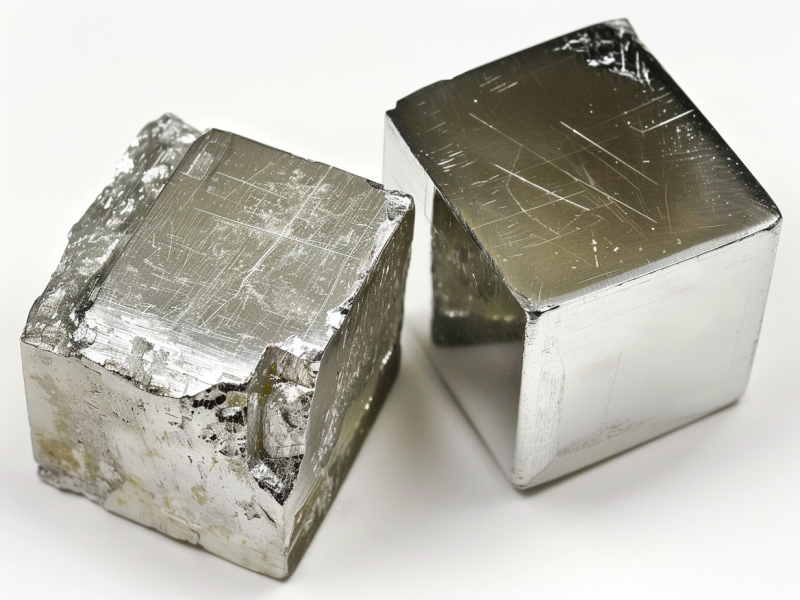
Introduction
Scandium and yttrium, two members of the rare earth element family, are known for their unique properties and applications. Both elements play crucial roles in various high-tech and industrial fields, but they also exhibit distinct characteristics that set them apart. This article explores the similarities and differences between scandium and yttrium, providing insights into their properties, uses, and economic significance.
Basic Properties
Scandium
- Symbol: Sc
- Atomic Number: 21
- Density: 2.985 g/cm³
- Melting Point: 1541°C
- Appearance: Silvery-white metal
Yttrium
- Symbol: Y
- Atomic Number: 39
- Density: 4.472 g/cm³
- Melting Point: 1526°C
- Appearance: Silvery-white metal
Both scandium and yttrium are transition metals and share a silvery-white appearance. However, yttrium has a higher density and a slightly lower melting point compared to scandium.

Chemical Behavior
Similarities
- Oxidation State: Both scandium and yttrium typically exhibit a +3 oxidation state, forming stable trivalent compounds.
- Reactivity: Both metals react with oxygen to form oxides (Sc₂O₃ for scandium and Y₂O₃ for yttrium) and with water to release hydrogen gas.
- Compounds: Scandium and yttrium form similar types of compounds, such as chlorides (ScCl₃ and YCl₃) and nitrates (Sc(NO₃)₃ and Y(NO₃)₃).
Differences
- Solubility: The solubility of their compounds can differ. For instance, yttrium hydroxide (Y(OH)₃) is more soluble in water than scandium hydroxide (Sc(OH)₃).
- Thermal Stability: Yttrium compounds generally exhibit higher thermal stability compared to scandium compounds.
Applications
Scandium
- Aerospace: Scandium is used in aluminum-scandium alloys to produce lightweight, strong components for aerospace applications.
- Sports Equipment: Scandium alloys are used in high-performance sports equipment, such as bike frames and baseball bats.
- Lighting: Scandium is used in metal halide lamps, providing high-intensity light with good color rendering.
Yttrium
- Electronics: Yttrium is used in phosphors for color television tubes and LEDs, providing red color.
- Medical: Yttrium-90 is used in cancer treatment for targeted radiotherapy.
- Materials Science: Yttrium is used in the production of yttria-stabilized zirconia (YSZ), which is crucial for high-temperature applications and solid oxide fuel cells.
Both elements are essential in advanced technologies, but their specific applications highlight their unique properties. Scandium’s lightweight and strength benefits are particularly valuable in aerospace and sports, while yttrium’s role in electronics and medical applications showcases its versatility.
Economic and Industrial Relevance
Scandium
Scandium is a relatively rare element with limited primary production sources. Its high value and demand in high-performance applications make it a critical material, particularly in industries seeking weight reduction and enhanced material properties.
Yttrium
Yttrium, although also a rare earth element, is more abundant and has more established supply chains. Its widespread use in electronics, medical applications, and high-temperature materials makes it a staple in various high-tech industries.
Environmental and Biological Aspects
Environmental Impact
Both scandium and yttrium have relatively low environmental impacts when used properly. However, the extraction and processing of these metals can pose environmental challenges, requiring careful management to minimize adverse effects.
Biological Roles
Neither scandium nor yttrium play significant biological roles in the human body. They are generally considered non-toxic, although their compounds should be handled with care to avoid potential health risks from prolonged exposure.
Conclusion
Scandium and yttrium, while sharing several similarities as rare earth elements, also exhibit distinct properties that make them uniquely valuable in different applications. Understanding these similarities and differences is crucial for leveraging their strengths in various high-tech and industrial fields. As scandium continues to gain prominence, particularly in aerospace and sports equipment, its unique advantages will drive further innovations and applications. For more information on scandium and to explore our scandium-related products, visit our comprehensive resources and product pages.
Explore the potential of scandium and yttrium in your projects and discover how these remarkable elements can enhance your materials and technologies.
